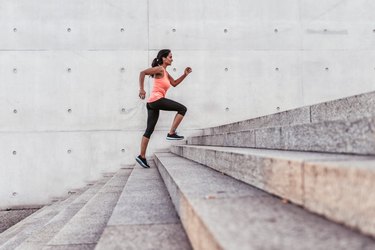
Getting a red face during exercise is as normal as sweating for some people. In most cases, a red face following exercise is perfectly normal and no cause for concern. It is more prevalent in people with fair skin and is just part of your genetic make-up.
The amount of time it takes for your face to return to normal also varies between individuals. Factors like fitness level and the intensity of the exercise will also affect the level of redness.
Video of the Day
Video of the Day
Tip
Getting a red and hot face from exercising could just mean you've over-exerted; but it could also mean you have vasodilation going on underneath your skin. That means your blood vessels widen to deliver oxygen to your muscles.
Exertion and Circulation
When you begin exercising, many changes take place inside your body. You breathe more quickly and your lungs work harder to provide the bloodstream with more oxygen. Your heart rate increases as your heart works harder to increase the blood flow to the muscles that you are working. So that your cardiovascular system can work harder, small blood vessels and capillaries widen to deliver the oxygen to the muscles and remove waste products. This widening is called vasodilation, according to the University of Georgia, and makes your face redden as more blood is being carried by the capillaries beneath your skin.
Heat Dissipation Through Vasodilation
As you exercise and work your muscles, your body temperature increases. The dilated blood vessels carry an increased blood flow to your skin where it transfers heat to your surroundings to prevent you from overheating. You also sweat to cool down.
Both of these factors can lead to a red face, and you can expect your face to get redder when exercising in hot weather than in cool weather. However, if a flushed face is also combined with dizziness, nausea or fatigue, it could be due to other reasons and you should stop exercising immediately.
Other Causes of Redness
A red face during exercise can be normal for many people, but if it is accompanied by a dry mouth, thirst and dizziness, it can be a sign of dehydration. This can lead to hyperthermia or heatstroke which is a serious medical problem, says Mayo Clinic.
Symptoms of hyperthermia can include a red face; dizziness; nausea; fast, shallow breathing; vomiting; and a fast heart rate. If your red face is accompanied by these symptoms or by light-headedness, heart palpitations or difficulty breathing, then you should see a medical professional. The skin condition rosacea can also be exacerbated by exercise, making your face redder.
Read more: Why Drink Water After Exercising?
Toning Down the Red
While you are unlikely to stop your face from getting red when you exercise, there are preventative measures you can take to minimize the redness. Drink plenty of water to keep yourself hydrated and exercise in a cool environment advises the American Council on Exercise. If you exercise outdoors, avoid the middle of the day and early afternoon during the summer months, as keeping your body temperature low can minimize the redness. Wear loose-fitting clothing and reduce the intensity of the workout to reduce redness.
- MayoClinic.org: "Heatstroke"
- American Academy of Dermatology: "Rosacea"
- ACE Fitness: "Considerations for Exercising in the Heat"
- University of Georgia: "Changes in Vessel Caliber"
- ABC Health and Wellbeing: Fact: Buster: Is a Red Face a Sign Someone Has High Blood Pressure?
- Med Help: Dermatology: Red Hot Face
- Nutritional Sciences: From Fundamentals to Food; Michelle McGuire and Kathy A. Beerman